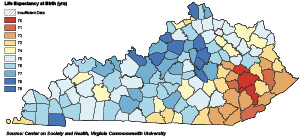Clinton residents’ life expectancy lags behind Kentucky average


By Al Cross
Kentucky Health News
Lives spent in four counties of the Eastern Pennyroyal Region – Clinton, Cumberland, Metcalfe and Monroe – are expected to be shorter than those spent in the counties that surround them.
Health researchers say life expectancy, perhaps the most basic measure of a community’s health, is driven by a complex web of factors that influence health — opportunities for education and jobs, safe and affordable housing, availability of nutritious food and places for physical activity, and access to health care, child care and social services.
Life expectancy in Clinton and Metcalfe counties is 74 years, two years less than the state average. In Cumberland and Monroe counties it’s 73 years.
In counties surrounding the area, the numbers are 75 in Allen, 76 in Barren, 78 in Hart, 76 in Green, 77 in Adair and 76 in Russell and Wayne.
The numbers are on a Kentucky life expectancy map released Monday by researchers at the Virginia Commonwealth University Center on Society and Health and the Robert Wood Johnson Foundation. It shows that chances to lead a long and healthy life can vary dramatically by county. Life expectancy is perhaps the most basic measure of a community’s overall health.
“Health differences between communities are rarely due to a single cause,” the researchers said in a press release. “The health differences shown in these maps aren’t unique to one area. We see them in big cities, small towns, and rural areas across America,” said Derek Chapman, the VCU center’s associate director for research.
The map is the latest effort by the Robert Wood Johnson Foundation to raise public awareness of the many factors that shape health, particularly social and economic factors.
Another is the County Health Rankings, done annually by the University of Wisconsin Population Health Institute. In the rankings of Kentucky’s 120 counties, Clinton County ranks 102nd in health outcomes, which include life expectancy, and 103rd in the health factors that influence those outcomes.
For example, the rankings show that 56 percent of Clinton County’s traffic deaths involve alcohol, much more than the statewide figure of 29 percent, and that 6.7 of every 100 teenage girls in the county deliver a child, compared to the statewide rate of 4.7 per 100.
The complete rankings for Clinton County are available at http://www.countyhealthrankings.org/app/kentucky/2016/rankings/clinton/county/outcomes/overall/snapshot.
Pickett County, Tennessee fares better in the rankings: 16th in health outcomes, but 71st in health factors, among 95 Tennessee counties.
The Kentucky Department for Public Health says it and its partners have several efforts underway to tackle the many factors that shape health:
• Promotion of farmers’ markets and their acceptance of federal food assistance benefits such as SNAP, WIC and Senior Farmers’ Market Nutrition Program Vouchers, incentive programs to help with affordability and community outreach.
• Promotion of walking and walkability by providing communities with targeted training and technical assistance to develop pedestrian plans.
• Protecting youth from tobacco exposure through the “100 percent Tobacco Free Schools” program, which provides guidance to districts that wish to reduce tobacco use by students and staff.
Experts say local efforts are needed, too.
“We must build a society where everyone, no matter where they live, the color of their skin, their financial or family situation, has the opportunity to lead a productive, healthy life,” said RWJF President and CEO Risa Lavizzo-Mourey. “There’s no one-size-fits-all solution. Each community must chart its own course, and every person has a role to play in achieving better health in their homes, their communities, their schools and their workplaces.”
Kentucky Health News is an independent news service of the Institute for Rural Journalism and Community Issues, based in the School of Journalism and Media at the University of Kentucky, with support from the Foundation for a Healthy Kentucky.


